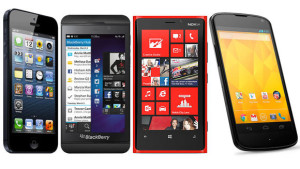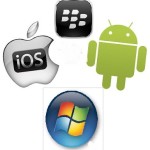Messaging
To some people, especially the very young ones, I tell you this, smart phones can still make phone calls. Seriously, they do. But in this age, messaging is the king. Back then, the only way of messaging electronically through a phone was a simple SMS message, but now there are lots of ways to send message to others. Makes you feel old doesn’t it?
Android – Google
We’ll kick off with Android which comes with separate text messaging and email apps pre-installed which are perfectly functional, but pop over to Google Play and you’ll be met with dozens, hundreds of messaging options (most of which are free) such as WhatsApp and Skype.
Because manufacturers are allowed to tinker with the Android platform before sticking it on their devices you get a slightly different experience from each company, so it will probably be worth trialling some handsets in store before making a final decision – with keyboards usually the sticking point.
The stock Android offering is serviceable but not every manufacturer decides to stick with it; firms such as HTC and Huawei opt to install their own keyboards, with varying degrees of success.
The big advantage of Android is that it provides a way for people to use custom made keyboard. Even though the Android keyboard is functioning well, it still doesn’t hurt if one would try and use the many keyboards (mostly free) available in Google Play.
iOS – Apple
Over on iOS 6 and unsurprisingly Apple allows you to use its keyboard only, with no support for third party apps to come in and steal the show.
That said, the iOS keyboard is a decent, responsive and generally accurate input method which allows users to rack up a good typing speed.
As far as messaging goes, like Jelly Bean, iOS 6 comes with separate text and email apps, but there’s an additional offering out of the box in the form of iMessage.
iMessage is Apple’s answer to BlackBerry’s BBM messaging service, allowing iPhone users to message each over for free without the worry of eating into their text message allowance.
Third party messaging apps can be downloaded from the App Store in the same way they can on Jelly Bean with many applications providing cross-platform support.
Blackberry 10 – Blackberry
BBM is still going strong over on BlackBerry 10 which sports the all new BlackBerry Hub – a universal inbox for every message your phone is capable of receiving.
Everything from texts and emails to missed calls, BBMs and social updates pop up in the Hub, making it your one-stop shop for communication.
You can reply via any account via the Hub meaning you don’t need to fire up the official BBM, Facebook, Twitter etc apps to tap out a response.
The Hub can be filtered to just show one account if it all gets a bit confusing and it’s a system we’re fond of – it’s probably the best feature on BlackBerry 10.
Windows Phone 8 – Microsoft
Windows Phone 8 returns us to the status quo with separate apps for texts, emails and third party messaging apps, but an added extra here is the inclusion of Windows Live messenger – something which is being rolled into the now Microsoft-owned Skype package.
From within the text messaging app you can slide over to your online Messenger profile and instant chat with any of your buddies who are online – handy.
Both BlackBerry 10 and Windows Phone 8, like iOS, don’t allow you to install alternative keyboards meaning you’re stuck with the default offerings.
Neither is particularly bad, but we’ve had more accurate typing experiences on other handsets than both the Windows Phone and BlackBerry input methods. We’ll be fair though and point out that it’s really what you get used to that defines how good a system is… it’s just Microsoft and BlackBerry’s efforts are a little harder to learn correctly.
Messaging has been the one of the top most used way of communicating. Various ways have been created to make messaging across the world more interactive and more reliable.







